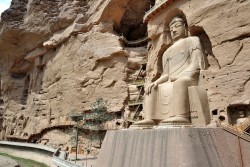

Introducing White Pagoda Mountain
The White Pagoda Mountain, famous for its namesake white pagoda built during the Yuan Dynasty (1271-1368), stands as a natural fortress for Lanzhou with its elevation of 1,700 square meters (18,299 square feet). The mountain hosts the White Pagoda Mountain Park, which is home to the historic White Pagoda. The park spans an area of 8,000 square meters (approximately two acres) and contains three impressive ancient architectural structures. The park is adorned with old trees, and a winding path leads to a tranquil retreat.
Additional attractions in the White Pagoda Mountain Park include the enigmatic Yellow River Stone Hall and the Reception Tent representing the Yugu ethnic group. A sweeping view of Lanzhou City can be enjoyed from the pagoda. The mountain, together with the Zhongshan Bridge at its base, paints a picturesque landscape that is emblematic of Lanzhou City.
White Pagoda Mountain Fast Facts
• AKA: White Pagoda Hill
• Chinese Name: Bai Ta Shan 白塔山
• Best Time to Visit: March to September
• Recommended Visiting Hours: About 2 to 4 hours
• Things to Do: Photography, Nature, Lanzhou History and Culture
• Opening Hours: 06:00-18:00
• Entrance Fee: Free
• Address: Binhe Central Road, Qilihe District, Lanzhou, Gansu Province
Reasons to Visit the White Pagoda Mountain
The Iconic White Pagoda: Standing proudly atop the mountain, the White Pagoda is a majestic symbol of Lanzhou. This 17-meter tall, seven-story structure boasts a unique inverted-bowl base and exquisite brickwork, dating back to the Yuan Dynasty. Climb the winding stairs to the top and be rewarded with panoramic vistas of the city and the Yellow River snaking through it.
Capture Panoramic Views: White Pagoda Mountain is a photographer’s paradise. Capture breathtaking shots of the Yellow River winding through the city, the sprawling cityscape bathed in golden sunlight, and the majestic mountains in the distance. At dusk, witness the city transform into a glittering tapestry of lights.
Immerse Yourself in Nature: Breathe in the fresh air and wander through the picturesque park grounds. Lush greenery, vibrant flowers, and ancient trees create a tranquil escape from the city’s bustle. Stroll along winding paths, admire the intricate pavilions and archways, and soak in the serenity of the landscape.
What to Expect at the White Pagoda Mountain
The White Pagoda Mountain Park, which includes the entire temple complex, extends from the mountain’s peak to the Zhongshan Yellow River Bridge at its base. The mountain’s foot is distinguished by Jincheng Pass and Yudie Pass, former military strongholds in ancient times. The park’s notable features include the Yellow River Stone Hall, a small exhibit showcasing stones from the Yellow River; the Yugur Reception Tent, a cultural immersion experience for visitors to learn about the Yugur ethnic minority; and the Gongbei Mosque, one of Lanzhou’s largest mosques.
White Pagoda
The White Pagoda was originally erected during the Yuan Dynasty (1271-1368), refurbished in the Ming Dynasty (1368-1644), and further expanded in 1715 during the Qing Dynasty. It was built to commemorate a Tibetan Lama who tragically fell ill and passed away while on his journey to meet Genghis Khan. The existing pagoda stands tall at 17 meters (approximately 56 feet) and consists of seven levels. Its white facade is beautifully offset by a green pinnacle at the top. The pagoda is octagonal, with each side adorned with intricate Buddhist designs. Tiny iron bells dangle from the eaves of each level of the pagoda, creating a calming melody whenever the wind sweeps across the mountain. From the top of the pagoda, visitors are treated to a sweeping view of Lanzhou City.
Three Treasures of White Pagoda Mountain
Historically, the temple complex on the White Pagoda Mountain was celebrated for its three treasures: the Elephant Leather Drum, the Bronze Bell, and the Chinese Redbud Tree. Regrettably, the Chinese redbud trees that once flourished on the mountain have all perished due to the depletion of their water sources. However, the Elephant Leather Drum and the Bronze Bell have endured over time. The Elephant Leather Drum, a massive drum, is believed to have been gifted to the temple by an unidentified Indian monk. The Bronze Bell, on the other hand, was forged during the Qing Dynasty and boasts an impressive weight of 153 kilograms!
How to Get to White Pagoda Mountain
By Bus: Take bus 20, 35, 53, 108, 131 to Baitashan Gongyuan (White Pagoda Park).
Additional Travel Advice on White Pagoda Mountain
• Visitors can take chairlift to the hillside of the mountain.
• Please wear body lotion, lip balm and hand cream as it is always dry in Lanzhou.